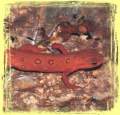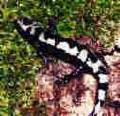Last updated 27 January 2001 with thumbnail images.
FROM NOVICE TO EXPERT (1)
LEVEL 1: Good for beginners, easy to learn anuran-keeping with.
Fire Salamander (Salamander salamandra)
 One
of the visually most striking salamanders in Europe, if not the world, and also
very adaptable to captivity, as long as two things are remembered: (a) Fire
Salamanders like it cool and (b) Fire Salamanders cannot swim. In other
words, don't leave a large pool of water in with them and make sure they can
be kept cool during the summer - temperatures over 70 deg. F can kill them.
Apart from these two basic requirements Fire Salamanders are pretty hardy. Incidentally,
if a breeding pair is kept then a shallow area of water is normally needed
for the larvae, although a few subspecies do apparently give birth to fully-formed
terrestrial young.
One
of the visually most striking salamanders in Europe, if not the world, and also
very adaptable to captivity, as long as two things are remembered: (a) Fire
Salamanders like it cool and (b) Fire Salamanders cannot swim. In other
words, don't leave a large pool of water in with them and make sure they can
be kept cool during the summer - temperatures over 70 deg. F can kill them.
Apart from these two basic requirements Fire Salamanders are pretty hardy. Incidentally,
if a breeding pair is kept then a shallow area of water is normally needed
for the larvae, although a few subspecies do apparently give birth to fully-formed
terrestrial young.
Tiger Salamander (Ambystoma tigrinum)
 The
North American Tiger Salamander has a lot going for it: size (about 12"), stripes,
what looks like a permanent grin, and a surprising amount of intelligence. Many
keepers report that their tigers often follow them along the side of the tank
expecting food, and Ellen Chernoff in Reptile Hobbyist related an interesting
method of communicating with them by stroking their heads. Tiger Salamanders
are another terrestrial species but have less of an aversion to water than Fire
Salamanders.
The
North American Tiger Salamander has a lot going for it: size (about 12"), stripes,
what looks like a permanent grin, and a surprising amount of intelligence. Many
keepers report that their tigers often follow them along the side of the tank
expecting food, and Ellen Chernoff in Reptile Hobbyist related an interesting
method of communicating with them by stroking their heads. Tiger Salamanders
are another terrestrial species but have less of an aversion to water than Fire
Salamanders.
Eastern Newt (Notopthalmus viridescens)
 Indiviglio
suggests the Eastern Newt as a "first species" due to their hardiness in captivity,
ready availability and interesting life cycle, which has three stages instead
of the usual two. Eastern Newts start off life as conventional larvae, then
metamorphose into a terrestrial form known as the 'red eft' (the bright red
colour of this stage indicates the creature's high toxicity if eaten!). They
remain like this for a period of anything between one and year before becoming
aquatic upon reaching sexual maturity, when they return to the water to breed
and remain in this stage thereafter. They rarely grow larger than 4" long and
so can be housed in a reasonably modest aquarium and not disturb any naturalistic
setup. Even in the terrestrial stage, however, these creatures should have a
moist environment. Setups for the aquatic phase should be fairly well planted.
Indiviglio
suggests the Eastern Newt as a "first species" due to their hardiness in captivity,
ready availability and interesting life cycle, which has three stages instead
of the usual two. Eastern Newts start off life as conventional larvae, then
metamorphose into a terrestrial form known as the 'red eft' (the bright red
colour of this stage indicates the creature's high toxicity if eaten!). They
remain like this for a period of anything between one and year before becoming
aquatic upon reaching sexual maturity, when they return to the water to breed
and remain in this stage thereafter. They rarely grow larger than 4" long and
so can be housed in a reasonably modest aquarium and not disturb any naturalistic
setup. Even in the terrestrial stage, however, these creatures should have a
moist environment. Setups for the aquatic phase should be fairly well planted.
Japanese Fire-Bellied Newt (Cynops
pyrrhogaster)
 A
hardy member of the Family Salamandridae that spends most of its life
in the water. Being usually only 4-5" long, a small group of these newts can
be accommodated in a modest-sized aquarium. The aquarium should hold mostly
water with either a small land area or floating areas for the newts to climb
onto: they are not particularly terrestrial and do not require much in the way
of dry land. The water area, however, should be well-planted as the natural
habitat of Cynops pyrrhogaster tends to be quiet water areas with a fair
amount of plant growth. For the same reason filtration can and should be fairly
low-powered (Indiviglio, see Bibliography).
A
hardy member of the Family Salamandridae that spends most of its life
in the water. Being usually only 4-5" long, a small group of these newts can
be accommodated in a modest-sized aquarium. The aquarium should hold mostly
water with either a small land area or floating areas for the newts to climb
onto: they are not particularly terrestrial and do not require much in the way
of dry land. The water area, however, should be well-planted as the natural
habitat of Cynops pyrrhogaster tends to be quiet water areas with a fair
amount of plant growth. For the same reason filtration can and should be fairly
low-powered (Indiviglio, see Bibliography).
Emperor/Crocodile Newt (Tylototriton spp)
 Strictly
speaking this creature from Asia is a salamander rather than a newt since it
is rarely aquatic, although it will enter shallow water to eat (Indiviglio).
While very hardy, they should be kept on the cool side (not more than 70 deg
F if possible) and it should be noted that most of them on arrival in the country
of import are in poor condition from their journey. They are an attractive bright
orange colour and grow to 7-8". As they are somewhat inactive compared to other
salamanders they should not be overfed.
Strictly
speaking this creature from Asia is a salamander rather than a newt since it
is rarely aquatic, although it will enter shallow water to eat (Indiviglio).
While very hardy, they should be kept on the cool side (not more than 70 deg
F if possible) and it should be noted that most of them on arrival in the country
of import are in poor condition from their journey. They are an attractive bright
orange colour and grow to 7-8". As they are somewhat inactive compared to other
salamanders they should not be overfed.
Mole Salamanders (Ambystomidae)

 Members
of the Ambystoma family of North America can be kept in captivity, and
two in particular are reported to make attractive and fairly hardy pets. The
Spotted Salamander Amystoma maculatum occurs in the east of North America
from southern Ontario as far south as Texas and is a creature of cool climates,
some apparently actually crossing snow-covered ground on their way to their
breeding ponds (Inviglio). Care is similar to that of the Tiger Salamander,
although the Spotted Salamander is smaller (5-7") and less forward in coming
out of its shelter. The Marbled Salamander Ambystoma opacum has a similar
range, is slightly smaller (3½-4½") and more secretive. Inviglio suggests a
fairly deep terrarium with a good depth of substrate to allow burrowing.
Members
of the Ambystoma family of North America can be kept in captivity, and
two in particular are reported to make attractive and fairly hardy pets. The
Spotted Salamander Amystoma maculatum occurs in the east of North America
from southern Ontario as far south as Texas and is a creature of cool climates,
some apparently actually crossing snow-covered ground on their way to their
breeding ponds (Inviglio). Care is similar to that of the Tiger Salamander,
although the Spotted Salamander is smaller (5-7") and less forward in coming
out of its shelter. The Marbled Salamander Ambystoma opacum has a similar
range, is slightly smaller (3½-4½") and more secretive. Inviglio suggests a
fairly deep terrarium with a good depth of substrate to allow burrowing.
Back |
Next |
Back to Amphibians |
Back to HomePage
 One
of the visually most striking salamanders in Europe, if not the world, and also
very adaptable to captivity, as long as two things are remembered: (a) Fire
Salamanders like it cool and (b) Fire Salamanders cannot swim. In other
words, don't leave a large pool of water in with them and make sure they can
be kept cool during the summer - temperatures over 70 deg. F can kill them.
Apart from these two basic requirements Fire Salamanders are pretty hardy. Incidentally,
if a breeding pair is kept then a shallow area of water is normally needed
for the larvae, although a few subspecies do apparently give birth to fully-formed
terrestrial young.
One
of the visually most striking salamanders in Europe, if not the world, and also
very adaptable to captivity, as long as two things are remembered: (a) Fire
Salamanders like it cool and (b) Fire Salamanders cannot swim. In other
words, don't leave a large pool of water in with them and make sure they can
be kept cool during the summer - temperatures over 70 deg. F can kill them.
Apart from these two basic requirements Fire Salamanders are pretty hardy. Incidentally,
if a breeding pair is kept then a shallow area of water is normally needed
for the larvae, although a few subspecies do apparently give birth to fully-formed
terrestrial young.




